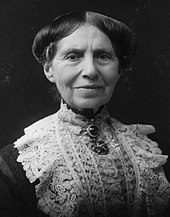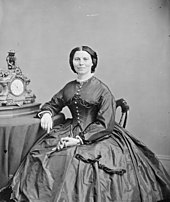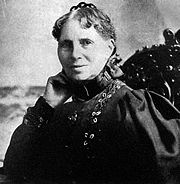Clara Barton
Clarissa Harlowe Barton (born December 25, 1821 in North Oxford , Massachusetts , † April 12, 1912 in Glen Echo , Maryland ), called Clara Barton , was an American nurse , teacher and philanthropist . She founded the American Red Cross and also had a great influence on the self-image of the International Red Cross and Red Crescent Movement .
The expansion of the activities of the national Red Cross and Red Crescent Societies beyond the original mission as aid organizations for use in armed conflicts to include relief measures in the event of natural disasters and similar emergency situations is largely based on the experience and commitment of Clara Barton. In addition, she initiated the establishment of the world's first tracing service for missing persons, a task that today occupies a central place in the work of the International Committee of the Red Cross (ICRC).
Youth and education
Clara Barton was on December 25, 1821 Oxford in Worcester County of Massachusetts as the daughter of Stephen and Sarah Barton. She received her schooling mainly at home and from her two brothers and two sisters. Her siblings were more than ten years older. Clara was able to spell her first words at the age of three.
At the age of eleven she began caring for her sick brother for two years. It taught her how to administer medication and how to care for a sick person: Nursing experiences that shaped her future life.
Activity as a teacher
She began teaching at a very young age, according to various sources between the ages of 15 and 18. For the first ten years she worked in a small Massachusetts town where one of her brothers owned a factory. Soon after starting a new job in Bordentown, New Jersey , she saw the need for free schools and, despite some difficulties, founded one of the first free schools in New Jersey. Although she led the school to success in no time, as a woman in the 19th century she did not have the necessary rights to officially function as headmistress . The post was transferred to a man and Clara Barton resigned.
In 1854 she suffered a nervous breakdown , presumably due to work-related overexertion . That same year she moved to Washington, DC , where she became the United States' first female government employee to serve as a secretary in the Patent Office .
American Civil War
When the American Civil War began, Barton resigned from her post in Washington. Like many other women, she volunteered to care for wounded soldiers. She quickly realized that the army was ill-prepared in medical matters. After the first battle at Bull Run in July 1861, she managed to set up a company for the procurement and distribution of medical supplies to wounded soldiers. Barton had to fight bureaucratic obstacles for over a year in order to be allowed to bring his own relief supplies to the battlefields. Her experiences from Washington were certainly a help. In July 1862, she finally received the permission she wanted to help on some of the most terrible battlefields of the Civil War, such as the Siege of Petersburg and Richmond . The origin of the wounded soldiers did not matter to her, she helped both wounded Northern and Southern fighters . Unbeknownst to Henry Dunant's experiences at the Battle of Solferino in Italy in 1859, their actions were guided by the same principles that, on the initiative of Henry Dunant, led to the establishment of the International Committee of Aid Societies for the Care of Wounded in 1863, which was renamed in 1876 in “International Committee of the Red Cross” (ICRC). In 1864 she was officially appointed head of his front-line hospitals by General Benjamin Franklin Butler . For her three years of service at the front, she was given the appreciative nicknames "Angel of the battlefield" and "American Florence Nightingale ".
When the Civil War ended in the spring of 1865, Barton was over 40 years old. She called on Abraham Lincoln and asked him to set up an office that relatives and acquaintances of missing members of the Army could contact. From 1866 to 1869, Barton raised funds for this facility. Barton's Office of Correspondence was the world's first missing person tracing service of its kind. With the help of the organization, over 30,000 fates have been clarified.
Trip to europe
In August 1869, Clara Barton felt exhausted. Together with her sister, she traveled to Europe for a vacation. During her stay in Switzerland, she met Louis Appia , a founding member of the predecessor institution of what later became the International Committee of the Red Cross (ICRC). Through him she learned about Henry Dunant and the idea of an international humanitarian organization that wanted to take care of the wounded during wars. The Geneva Convention had been adopted five years earlier .
During Barton's stay in Europe, the Franco-Prussian War began in 1870 . In Strasbourg she looked after the civilian population; in Paris she set up workshops for women so that they could earn a living. For her commitment, she was honored by the German Emperor Wilhelm I with the Cross of Merit for Women and Virgins .
American Red Cross
In 1873 she returned to the USA, where she recovered from the exertions in a sanatorium. At the same time she tried to get the USA to join the Geneva Convention and to set up a Red Cross organization in the United States. When she began building the American Red Cross in 1873, no one in the United States believed that the country would ever have a similar experience of the Civil War again. However, she managed to convince the government of President James A. Garfield that the Red Cross could be of great use in other types of crisis and disaster. It expanded the original idea of the Red Cross accordingly and thus had a great influence on the self-image of the International Red Cross and Red Crescent Movement.
In 1878 it wrote and published under the title "The Red Cross of the Geneva Convention. What It Is “a text addressed to all citizens of the United States, but especially to the senators and members of the Congress, in which they described the origins and goals of the Red Cross idea and the contents of the Geneva Convention. She was campaigning for support for the establishment of a section of the Red Cross in the USA and the accession of her home country to the Geneva Convention. Three years later, on May 21, 1881, the American Red Cross was officially established. Thanks to a generous donation from John D. Rockefeller , the headquarters in Washington DC was built near the White House . Because of her experience and commitment, Clara Barton became the organization's first female president. A year later, their efforts to get the United States to sign the Geneva Convention were also successful. In 1884 Barton represented the USA at the International Red Cross Conference and the International Peace Conference in Geneva . With an addendum initiated by her, it was stipulated that the Red Cross should not only provide assistance to victims of war but also to disaster victims in peacetime.
Clara Barton didn't like bothering with administration, however. She was a woman of action and went to theaters of disaster and war to help victims on the ground. It was active in floods, tornadoes, yellow fever and typhoid epidemics in the USA, in a famine in Russia, in the Armenian-Turkish war , in the war in Cuba, in the Russo-Japanese war and in other places. Barton was one of the first to combine humanitarian aid with rehabilitation programs. She expected that the disaster victims she cared for would not only buy food with the donated money, but as much seeds and tools as possible so that they could live independently again as quickly as possible. This "help for self-help" is now an integral part of the aid programs of the International Red Cross and Red Crescent Movement.
Late years
After 20 years as President of the American Red Cross, Clara Barton resigned from office in frustration due to internal power struggles. Already 86 years old, but still highly motivated, she built up a nationwide first aid society. For the last few years Barton lived in Glen Echo, Maryland. Her health deteriorated more and more. She also suffered from depression . She died in 1912 at the age of 90. Her grave in the family grave is just over a kilometer from the house where she was born.
| Clara Barton National Historic Site | ||
|---|---|---|
| Clara Barton's house, today's memorial | ||
|
|
||
| Position: | Maryland , United States | |
| Next city: | Glen Echo | |
| Surface: | 3.6 ha | |
| Founding: | October 26, 1974 | |
| Visitors: | 12,495 (2006) | |
memorial
In 1974, in the town of Glen Echo, Maryland, about two miles outside of Washington, DC, where Barton spent the last 15 years, the Clara Barton National Historic Site was established as a National Historic Site- type memorial for the National Park Service . Her life and work are remembered here, and her 15-room house can be viewed, which in addition to private living quarters also housed the first office and storage rooms of the American Red Cross.
Honors
A crater was named after Clara Barton . A park road that leads past Glen Echo, the Clara Barton Parkway , was also named after her .
literature
- Elizabeth Brown Pryor : Clara Barton, Professional Angel , University of Pennsylvania Press 1987, 1989
- Eve Marko: Clara Barton and the American Red Cross. Playmore Inc. Publishers, New York 1996, ISBN 0-86611-916-7 .
- Stephen B. Oates: A Woman of Valor: Clara Barton and the Civil War. The Free Press / Simon & Schuster Inc., New York 1995, ISBN 0-02-874012-2 .
- Ilona Scheidle: Clara Barton (1821-1912). Founder of the American Red Cross. In: Adelheid von Hauff (Ed.): Women shape diakonia. Vol. 2. From the 18th to the 20th century. Stuttgart 2006, pp. 290-302.
- Thomas Trent: Angels in Uniform: Life and Work of Three Unforgettable Women: Florence Nightingale , Clara Barton and Elsa Brandström . W. Fischer, Göttingen 1957 (= Göttingen youth volumes ).
Web links
- National Park Service: Clara Barton National Historic Site (official site; English)
- Clara Barton Birthplace Museum (English)
- The Red Cross of the Geneva Convention. What It Is text from Clara Barton's publication 1878
- Clara Barton National Historic Site ( Adobe Flash required)
Individual evidence
| personal data | |
|---|---|
| SURNAME | Barton, Clara |
| ALTERNATIVE NAMES | Barton, Clarissa Harlowe |
| BRIEF DESCRIPTION | American nurse, teacher, and philanthropist |
| BIRTH DATE | December 25, 1821 |
| PLACE OF BIRTH | North Oxford , Massachusetts |
| DATE OF DEATH | April 12, 1912 |
| PLACE OF DEATH | Glen Echo , Maryland |




